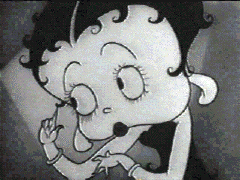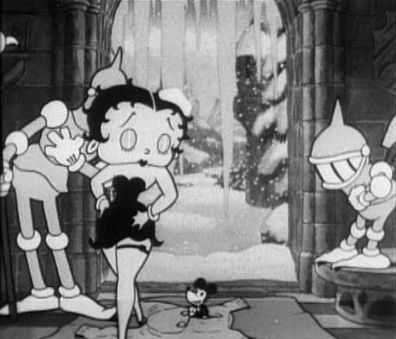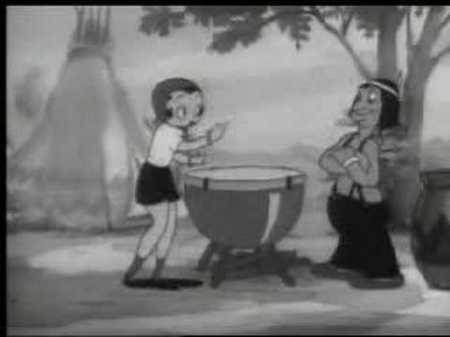Today’s guest blogger is Matt, who writes over at Yount Vs. Molitor. While his blog is about baseball cards and other sports topics, Matt has a formidable knowledge of classic film and is always welcome at l’eclisse. Enjoy!
A few notable examples not withstanding, the realm of mainstream animated film, up until the last fifteen years or so, has been largely aimed at a young audience. The sixties saw both the last of the short animated films released in theatres and the sale of those libraries for broadcast on television. These broadcasts, particularly the Saturday shows that would become a cultural ritual, cemented the image of cartoons as child’s play. However, early animated sound films were intended for a much wider audience. The Fleischer brothers, Max and David, were two of the early giants of this industry. Fleischer Studios developed a method of combining animation with live-action film called the Rotoscope. The Rotoscope style gave Fleischer’s cartoons a distinctive three-dimensional look. The Fleischers also developed the “bouncing ball” device for sing-a-long cartoons. Among Fleischer Studio’s star players were Koko the Clown, Popeye the Sailor, and a plucky young starlet named Betty Boop.

Betty as nameless Frech Poodle. Note the large ears.
Introduced in 1930 as a nameless poodle dressed in flapper fashions, the original Betty was the girlfriend of established Fleischer star pooch, Bimbo. In 1931, New Yorker Mae Questel took over vocal duties for Betty, providing her trademark squeaky voice. The following year, the character was officially christened as Betty Boop and assumed her more familiar human form, although she maintained her romantic interest in Bimbo for several films. Questel’s vocals, combined with Betty’s new look, drew comparisons to two flesh and blood stars, Helen Kane and Clara Bow. The original Betty poodle was indeed a caricature of Kane and she would later unsuccessfully sue the Fleischers, claiming infringement. The partnership of Questel and the Fleischers would being an eight year run of success.
Early Betty Boop cartoons reflect the unstable time in which they flourished. Betty is often shown at odds with modern urban life. Betty was a city girl, living in an absurd, Rube Goldbergian world. Just as Betty was an animal-come-human, the inanimate world around her would often spring to life, with talking clocks, galloping tables, and sexually-aggressive flowers. During the Great Depression, Betty’s struggles with the clatter of progress (Stop That Noise), ridiculous innovation (Betty Boop’s Crazy Inventions), or the decline of urban civility (Judge for a Day), resonated with an adult audience. The constant personification of everyday objects, combined with the generally trippy animating style of the Fleischers make the early Betty Boop Pictures a treat for the senses. The subtle cuteness and rhythmic silliness of it all works on levels that are far deeper than most cartoons of the era.

Classic Betty, pre-code. Note the short dress and exposed shoulders.
While not consciously political, Betty is unmistakably her own woman. She is only once shown to have parents and, aside from her canine boyfriend Bimbo, is rarely shown with a love interest. A female character, especially an animated one, who was not a wife, daughter, or object of pursuance was nearly non-existent at the time and remains a novelty today. Betty was almost always shown living by herself, driving (and sometimes flying) on her own. Betty worked, as a singer, as a business owner, even once as a candidate for President. Betty was also in command of her own sexuality. Much more prominently displayed in the early thirties, Betty had an obvious sexual nature. With a garter exposed and occasionally flashing a bit of cleavage, early Betty maintained an innocence that stayed true to her sly nature. While certainly also aware of her appeal, it was never used callously. Occasionally, her virtue was challenged, with 1932’s Chess-Nuts alluding to rape and Betty’s virginity. However, after a narrow escape, Betty proclaims that her “Boop-boop-be-doop” was not taken away.
Betty was tamed by the introduction of the Hays Code in 1933, with toned-down adventures and a more traditional home life and dress. Gone were the visible garter and low-cut dress, replaced with more modest clothing. Betty’s role in her own franchise also began to decline by the mid-thirties, while co-stars like Henry, an egg-bald nine-year-old sometimes billed (quite presumptuously as the ‘Funniest Man on Earth’), Pudgy, a troublesome pet dog, and Professor Grampy, an eccentric inventor. Betty’s role in these films would shrink as the decade progressed, eventually reduced to an ancillary character whose main contribution was musical, as Questel was busy with Popeye the Sailor, the Fleischer’s newest hit, providing the voice of Olive Oyl.

Betty in her final film, Rhythm on the Reservation.
By the late thirties, Betty’s appearance had become even more human, with her tiny feet and hands and melonous head adjusted in size. Her style of dress was also updated, more accurately reflected the fashion of the time. Betty’s final film, Rhythm on the Reservation is an unfortunately crude attempt at humor involving Betty on an Indian reservation. The film is comprised almost entirely of a single musical number (a common trait of later Betty films) and features some ugly stereotypes of Native Americans. A final cartoon was released under the Betty Boop banner, but she did not appear.
Betty’s transition to television was not as lucrative as some of her younger peers, owing largely to the fact that the vast majority of her 110 films were done in black and white (Although several were later colorized). Despite this, Betty Boop gained a second life beginning in the 1980s as a marketing tool. Betty’s image has graced thousands of items, from clothing to action figures, and is how most people know her today. Even with her ability to more merchandise, her original body of work remains somewhat obscure. About one-fifth of these films are currently in the public domain and viable for free on various websites. An eight tape VHS definitive collection was released in the 90’s and can be found used online. No official DVD release of Betty Boop films has ever been produced, but her public domain work can be purchased on DVD through amazon.com or eBay. Larger, unlicensed collections are also available and well worth the effort.
